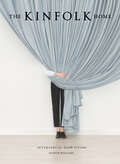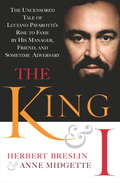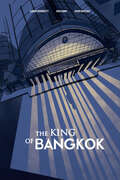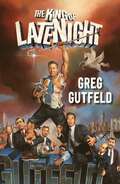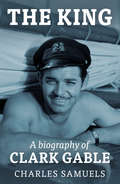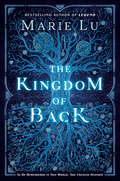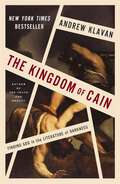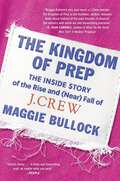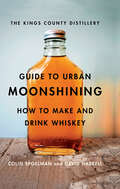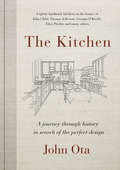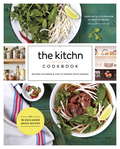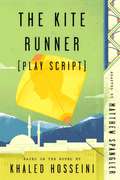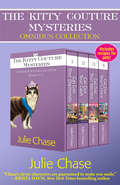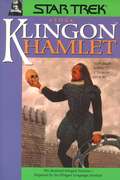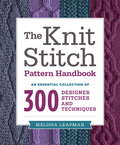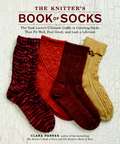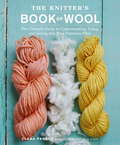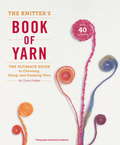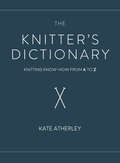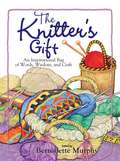- Table View
- List View
The Kinfolk Home: Interiors for Slow Living (Kinfolk Ser.)
by Nathan WilliamsNew York Times bestseller When The Kinfolk Table was published in 2013, it transformed the way readers across the globe thought about small gatherings. <P><P>In this much-anticipated follow-up, Kinfolk founder Nathan Williams showcases how embracing that same ethos—of slowing down, simplifying your life, and cultivating community—allows you to create a more considered, beautiful, and intimate living space. <P>The Kinfolk Home takes readers inside 35 homes around the world, from the United States, Scandinavia, Japan, and beyond. Some have constructed modern urban homes from blueprints, while others nurture their home’s long history. <P>What all of these spaces have in common is that they’ve been put together carefully, slowly, and with great intention. Featuring inviting photographs and insightful profiles, interviews, and essays, each home tour is guaranteed to inspire.
The King and I
by Anne Midgette Herbert BreslinLuciano Pavarotti's longtime manager and friend tells all. All.The King and I is the story of the thirty-six-year-old business relationship between Luciano Pavarotti and his manager, Herbert Breslin, during which Breslin guided what he calls, justifiably, "the greatest career in classical music." During that career, Breslin moved Pavarotti out of the opera house and onto the concert (and the world) stage and into the arms of a huge mass public. How he and Pavarotti changed the landscape of opera is one of the most significant and entertaining stories in the history of classical music, and Herbert Breslin relates the tale in a brash, candid, witty fashion that is often bitingly frank and profane. He also provides a portrait of his friend and client--"a beautiful, simple, lovely guy who turned into a very determined, aggressive, and somewhat unhappy superstar"--that is by turns affectionate and satirical and full of hilarious details and tales out of school, with Pavarotti emerging as something like the ultimate Italian male. The book is also enlivened by the voices of other players in the soap opera drama that was Pavarotti's career, and they are no less uncensored than Herbert Breslin. The last word, in fact, comes from none other than Luciano Pavarotti himself!The King and I is the ultimate backstage book about the greatest opera star of the past century--and it's a delight to read as well.
The King of Bangkok (ethnoGRAPHIC)
by Claudio Sopranzetti Sara Fabbri Chiara NatalucciThe English translation of this best-selling graphic novel tells the story of Nok, an old blind man who sells lottery tickets in Bangkok, as he decides to leave the city and return to his native village. Through reflections on contemporary Bangkok and flashbacks to his past, Nok reconstructs a journey through the slums of migrant workers, the rice fields of Isaan, the tourist villages of Ko Pha Ngan, and the Red Shirt protests of 2010. Based on a decade of anthropological research, The King of Bangkok is a story of migration to the city, distant families in the countryside, economic development eroding the land, and violent political protest. Ultimately, it is a story about contemporary Thailand and how the waves of history lift, engulf, and crash against ordinary people.
The King of Late Night
by Greg GutfeldGreg Gutfeld, five-time New York Times bestselling author and host of the #1 rated late night show GUTFELD!, returns with a witty and tongue-in-cheek essay collection that is part memoir and part political manifesto. <p><p> Greg Gutfeld is back with a hilarious essay collection about how he destroyed the mainstream late night landscape of heavyweights and became host of the #1 late night show in all of television. With his signature wit and whip-smart humor, Greg reveals never-before-told stories of his upbringing and early career, what it’s like going head-to-head with the liberal media, and what it took to flip the script on the comedy landscape. <p><p> How did the former health magazine editor take a show in a throwaway time slot in the middle of the night and turn it into a cult classic? And how did that show, Redeye, catapult Greg to The Five, the most watched show on TV, and GUTFELD!, his own late-night spot, with millions of viewers each night? Buckle up, because this story is one hell of a ride, especially if Greg is driving. <p> <b>New York Times Bestseller</b>
The King: A Biography of Clark Gable
by Charles SamuelsThe King was first published in 1961, shortly after the death of Hollywood legend Clark Gable in 1960. The book traces Gable's life from its humble, hard-scrabble beginnings in Ohio, to his hard-work and determined efforts to achieve success on Broadway, to his meteoric rise to stardom in Hollywood, his time spent in the Army Air Force in Europe, and his many loves, including Carole Lombard who was tragically killed in an airplane crash in 1942. The King paints an intimate, contemporary portrait of Clark Gable the man, both on and off camera, and ends with Gable's work on his last film, The Misfits, and his subsequent decline in health and his death on November 16, 1960, at age 59.
The Kingdom of Back
by Marie LuTwo siblings. Two brilliant talents. But only one Mozart. Born with a gift for music, Nannerl Mozart has just one wish--to be remembered forever. But even as she delights audiences with her masterful playing, she has little hope she'll ever become the acclaimed composer she longs to be. She is a young woman in 18th century Europe, and that means composing is forbidden to her. She will perform only until she reaches a marriageable age--her tyrannical father has made that much clear. <p><p> And as Nannerl's hope grows dimmer with each passing year, the talents of her beloved younger brother, Wolfgang, only seem to shine brighter. His brilliance begins to eclipse her own, until one day a mysterious stranger from a magical land appears with an irresistible offer. He has the power to make her wish come true--but his help may cost her everything. <p> In her first work of historical fiction, #1 New York Times bestselling author Marie Lu spins a lush, lyrically-told story of music, magic, and the unbreakable bond between a brother and sister. <P><P><b>A New York Times Bestseller</b>
The Kingdom of Cain: Finding God in the Literature of Darkness
by Andrew KlavanINSTANT NEW YORK TIMES BESTSELLER <br> Andrew Klavan explores how artists' imaginative engagement with the darkness can point the way to living beautifully in the midst of a tragic world. <br> "Andrew Klavan's book illuminates even as it explores the deepest darkness, finding truth and beauty in art born of unflinching confrontations with evil." --Daniel McCarthy, editor-in-chief, Modern Age <p> In his USA Today bestselling The Truth and Beauty, Andrew Klavan explored how the work of great poets helps illuminate the truth of the gospels. Now, the award-winning screenwriter and crime novelist turns his attention to the dark side of human nature to discover how we might find joy and beauty in the world while still being clear-eyed about the evil found in it. <p> The Kingdom of Cain looks at three murders in history--including the first murder, Cain's killing of his brother, Abel--and at the art created from imaginative engagement with those horrific events by artists ranging from Fyodor Dostoevsky to Alfred Hitchcock. To make beauty out of the world as it is--shot through with evil and injustice and suffering--is the task not just of the artist but, Klavan argues, of every life rightly lived. <p> Examining how that transformation occurs in art grants us a vision for how it can happen in our lives. Klavan eloquently argues that it is possible to be clear-eyed about the evil in the world while remaining hope-filled about God's ability to redeem it all. <b>New York Times Bestseller</b>
The Kingdom of Prep: The Inside Story of the Rise and (Near) Fall of J.Crew
by Maggie BullockOne of Vogue's most anticipated books of 2023.A quintessentially American fashion narrative about the rise and fall of the first lifestyle brand, J.Crew, and what the company’s fate means for the shifting landscape of the retail industry.Once upon a time, a no-frills J.Crew rollneck sweater held an almost mystical power—or at least it felt that way. The story of J.Crew is the story of the original “lifestyle brand,” whose evolution charts a sea change in the way we dress, the way we shop, and who we aspire to be over the past four decades—all told through iconic clothes and the most riveting characters imaginable.In The Kingdom of Prep, seasoned fashion journalist Maggie Bullock tells J.Crew’s epic story for the first time, bringing to life the deliciously idiosyncratic people who built a beloved brand, unpacking the complex legacy of prep—a subculture born on the 1920s campuses of the Ivy League—and how one brand rose to epitomize “American” style in two very different golden eras, and also eventually embodied the “retail apocalypse” that rocked the global fashion industry and left hollowed-out malls across the country.In a juicy business narrative rich with humor and insight, Bullock combines the colorful characters of The Devil Wears Prada, the business insight of Deluxe, and the nostalgia factor of True Prep, to chart J.Crew’s origin story, its Obama-era heyday, and its brush-with-death decline through the stories of the mercurial characters who helmed the company. There is founder Arthur Cinader, who set out to sell the Ralph Lauren look for half the price, and his daughter Emily, who turned J.Crew into a new campus uniform, and then a temple to ‘90s minimalism. Then came ex-Gap CEO Mickey Drexler—the most renowned (and controversial) retailer of his generation—who took J.Crew to a never-before-seen peak, only to contribute to its financial disaster, and the brilliant designer Jenna Lyons, who rose from the anonymous ranks of a catalogue company to become a star in her own right, but burned so bright she left J.Crew in her shadow.Through extensive interviews with more than 100 J.Crew insiders and top industry experts, Bullock crafts an impossible-to-put-down, neon-glitter-sprinkled tale that traces the trajectory of American style, invites us into the inner sanctum of fashion’s most bold-faced names, and weaves together the threads of style, finance, and culture like no other brand’s story in our lifetime.
The Kings County Distillery Guide to Urban Moonshining: How to Make and Drink Whiskey
by Colin Spoelman David HaskellThe whiskey companion from Brooklyn’s premier craft distillery—with a how-to guide to home distilling, history, recipes, and more.A new generation of urban bootleggers is distilling whiskey at home, and cocktail enthusiasts have embraced the nuances of brown liquors. Written by the founders of Kings County Distillery, New York City’s first distillery since Prohibition, this spirited illustrated book explores America’s age-old love affair with whiskey. It begins with chapters on whiskey’s history and culture from 1640 to today, when the DIY trend and the classic cocktail craze have conspired to make it the next big thing. For those thirsty for practical information, the book next provides a detailed, easy-to-follow guide to safe home distilling, complete with a list of supplies, step-by-step instructions, and helpful pictures, anecdotes, and tips. The final section focuses on the contemporary whiskey scene, featuring a list of microdistillers, cocktail and food recipes from the country’s hottest mixologists and chefs, and an opinionated guide to building your own whiskey collection.
The Kiss of the Nightingale
by Adi DennerA stolen magical gem transforms an orphan's destiny . . . a stunning and completely unputdownable romantasy novel set in an alternative historical Paris, The Kiss of the Nightingale weaves together the seduction of Bridgerton and the magic of Leigh Bardugo's Shadow and Bone series.1890, Lutèce: In this city, Talents are everything: precious gems that gift unrivalled skills to their owners. The most coveted, Elite Talents, are claimed by the aristocracy, passed through generations by blood magic.Cleodora dreamed of inheriting her father's Tailoring Talent, but when he died, the magic died with him. Now she&’s left with empty promises, a dress shop she can&’t keep afloat, and her bed-ridden younger sister.But everything changes when she meets the dark-eyed Lady Dahlia Sibille. Dahlia offers Cleodora a Singing Talent — a chance to save her beloved sister and rewrite her own fate. From the first instant, Cleodora is bewitched. . . there's just one catch: she needs to steal an Elite Talent from the prestigious Lenoir family.As Lutèce's nightingale, Cleodora is the star of the opera's galas and balls, worlds away from the darkness and dust of home. But the handsome yet infuriating Vicomte Lenoir is nothing like she expected.Soon, the Vicomte's teasing smiles win her over, even as Dahlia's seductive whispers linger in her ears. Torn between Dahlia, who gave her everything, and the Vicomte, who holds the price of her freedom, is Cleodora in danger of losing it all? Or can she prove that magic isn&’t the only gift that counts?
The Kiss of the Nightingale
by Adi DennerA stolen magical gem transforms an orphan's destiny . . . a stunning and completely unputdownable romantasy novel set in an alternative historical Paris, The Kiss of the Nightingale weaves together the seduction of Bridgerton and the magic of Leigh Bardugo's Shadow and Bone series.1890, Lutèce: In this city, Talents are everything: precious gems that gift unrivalled skills to their owners. The most coveted, Elite Talents, are claimed by the aristocracy, passed through generations by blood magic.Cleodora dreamed of inheriting her father's Tailoring Talent, but when he died, the magic died with him. Now she&’s left with empty promises, a dress shop she can&’t keep afloat, and her bed-ridden younger sister.But everything changes when she meets the dark-eyed Lady Dahlia Sibille. Dahlia offers Cleodora a Singing Talent — a chance to save her beloved sister and rewrite her own fate. From the first instant, Cleodora is bewitched. . . there's just one catch: she needs to steal an Elite Talent from the prestigious Lenoir family.As Lutèce's nightingale, Cleodora is the star of the opera's galas and balls, worlds away from the darkness and dust of home. But the handsome yet infuriating Vicomte Lenoir is nothing like she expected.Soon, the Vicomte's teasing smiles win her over, even as Dahlia's seductive whispers linger in her ears. Torn between Dahlia, who gave her everything, and the Vicomte, who holds the price of her freedom, is Cleodora in danger of losing it all? Or can she prove that magic isn&’t the only gift that counts?
The Kitchen: A journey through time-and the homes of Julia Child, Georgia O'Keeffe, Elvis Presley and many others-in search of the perfect design
by John OtaOne man's quest to seek out--and be inspired by--the great historic kitchens of Canada and the USA.John Ota was a man on a mission--to put together the perfect kitchen. He and his wife had been making do with a room that was frankly no great advertisement for John's architectural expertise. It just about did the job but for a room that's supposed to be the beating heart of a home and a joy to cook in, the Otas' left a lot to be desired. And so John set out on a quest across North America, exploring examples of excellent designs throughout history, to learn from them and apply their lessons to his own restoration. Along the way, he learned about the origins and evolution of the kitchen, its architecture and its appliances. He cooked, with expert instruction. And he learned too about the homes and their occupants, who range from pilgrims to President Thomas Jefferson, from turn of the century tenement dwellers to 21st century Vancouver idealists, from Julia Child to Georgia O'Keeffe, and from Elvis Presley to Louis Armstrong. John Ota has a refreshingly upbeat approach and a hunger for knowledge (and indeed for food). His energy and enthusiasm are contagious, and his insights of lasting value. Illustrated throughout, with photographs and also with drawings by the author, this is a book for homeowners, home makers, interior designers, cooks, armchair historians, and for anyone who--like John Ota before them--is looking for inspiration for a renovation.
The Kitchn Cookbook: Recipes, Kitchens & Tips to Inspire Your Cooking
by Faith Durand Sara Kate GillinghamFrom Apartment Therapy's cooking site, The Kitchn, comes 150 recipes and a cooking school with 50 essential lessons, as well as a guide to organizing your kitchen--plus storage tips, tool reviews, inspiration from real kitchens, maintenance suggestions, 200 photographs, and much more. WITH 18 RECIPES EXCLUSIVE TO THE EBOOK EDITION. "There is no question that the kitchen is the most important room of the home," say Sara Kate Gillingham and Faith Durand of the beloved cooking site and blog, The Kitchn. The Kitchn offers two books in one: a trove of techniques and recipes, plus a comprehensive guide to organizing your kitchen so that it's one of your favorite places to be. For Cooking: · 50 essential how-to's, from preparing perfect grains to holding a chef's knife like a pro · 150 all-new and classic recipes from The Kitchn, including Breakfast Tacos, Everyday Granola, Slow Cooker Carnitas, One-Pot Coconut Chickpea Curry, and No-Bake Banana and Peanut Butter Caramel Icebox Cake For Your Kitchen: · A shopping list of essentials for your cabinets and drawers (knives, appliances, cookware, and tableware), with insider advice on what's worth your money · Solutions for common kitchen problems like limited storage space and quirky layouts · A 5-minute-a-day plan for a clean kitchen · Tips for no-pressure gatherings · A look inside the kitchens of ten home cooks around the country, and how they enjoy their spaces The Kitchn Cookbook gives you the recipes, tools, and real-life inspiration to make cooking its own irresistible reward.
The Kite Runner (Play Script): Based on the novel by Khaled Hosseini
by Matthew SpanglerThe script for the stage production of Khaled Hosseini's first and internationally bestselling novel, The Kite Runner, as adapted by playwright Matthew Spangler. The unforgettable, heartbreaking story of the unlikely friendship between a wealthy boy and the son of his father's servant, The Kite Runner is a beautifully crafted novel set in a country that is in the process of being destroyed. Now adapted for the stage, the story is about the power of reading, the price of betrayal, and the possibility of redemption, and is an exploration of the influence of fathers over sons--their love, their sacrifices, their lies.A sweeping saga of family, love, and friendship told against the devastating backdrop of the history of Afghanistan over the last thirty years, The Kite Runner is an unusual and powerful story that has become a beloved, one-of-a-kind classic.This adaptation was first performed at Wyndham's Theatre, London, in December 2016.
The Kitty Couture Mysteries: Omnibus Collection: Books 1-4 (A Kitty Couture Mystery)
by Julie ChaseFans of Rita Mae Brown and Miranda James will delight in this four-book cozy mystery series perfect for cat lovers and mystery devotees. Opening Furry Godmother, pet boutique and organic treat bakery, is Lacy Marie Crocker&’s dream come true, but her life and business in the opulent New Orleans Garden District turns out to be more tumultuous than tame. Caught in one cat-and-mouse murder investigation after another, Lacy adds sleuthing to her list of qualifications—right after Shih Tzu tutu making. Including all four books in the Kitty Couture mysteries: Book 1 — Cat Got Your DiamondsArmed with a glitter gun, Lacy Marie Crocker finds her new business under threat when she becomes the top suspect in a murder.With Lacy&’s name at the top of the suspect list, Detective Jack Oliver is hounding her, and her Furry Godmother investor wants out before his name is tarnished by association. To make matters worse, a string of jewel heists with suspicious ties to the murder case has New Orleans residents on edge. To save her dream, Lacy must take a stand, put her keen eyes to work, and unravel what really happened at her shop the night of the murder. But can Lacy sniff out the killer cat burglar in time to get her tail-raising designs on the catwalk? Book 2 — Cat Got Your CashWhen top fashion designer Annie Lane is found dead and her adored Siamese cats are stolen, it&’s up to Lacy to catch the killer and recover the cats. When Lacy learns that the two cats stolen from a murder victim are set to inherit the dead designer&’s fortune, she begins to wonder if the killer was after Annie Lane&’s kittens all along. Lacy will stop at nothing to save the Siameses and find justice for Annie—if the killer doesn't sink his claws into her first. Luckily, Lacy has the help of handsome NOLA PD homicide detective Jack Oliver to help her catch the cat-napper before it&’s too late. Book 3 — Cat Got Your Secrets Lacy&’s own father is the prime suspect in a Valentine Day&’s death, and her father isn&’t the only one whose reputation is under threat. The last person to see the victim alive was her own father, so it&’s up to Lacy to clear her dad&’s name from the suspect list before Detective Jack Oliver has to cage him for good. But just when she starts pawing at the truth, she receives a threatening letter from a mysterious blackmailer bent on silencing her with her own secrets. And Lacy&’s not the only one with bones in her closet. Book 4 — Cat Got Your CrownWith a pet pageant around the corner and a killer unleashed, Lacy will have to collar the culprit before the claws come out.The entire Garden District seems to be counting the minutes until opening night of the pet pageant and everything is going spectacularly until Viktor Petrov, the pageant emcee takes a spill from the balcony during dress rehearsal. When it comes out that Viktor was notoriously rude, the doors blow wide open with potential suspects who could&’ve wanted him dead. Lacy&’s determined to find the killer and exonerate her accused friend Eva, but when Lacy receives a mysterious warning—a plush kitty from Lacy&’s shop with its mouth crudely stitched over—it&’s clear that she&’s been found first.
The Klingon Hamlet: Star Trek All Series (Star Trek )
by The Klingon Language InstituteAn astonishing effort on the part of the leading Klingon scholars of today, telling a story of blood, honour and vengeance in true Klingon tradition. With the English-language version printed on the left and the Klingon on the right, this best-known of Shakespeare's plays, a tour-de-force of Elizabethan theatre, can now be read and understood in the great warrior tongue even by non-Klingon speakers. As General Chang (Christopher Plummer) was heard to remark in the movie Star Trek IV: The Undiscovered Country: "Shakespeare is better in the original Klingon." Building on the groundwork of linguist Marc Okrand, author of The Klingon Dictionary, who constructed a fully spoken language out of what began as little more than a background prop, the Klingon Language Institute in Flourtown, Pennsylvania, is dedicated to the study and teaching of Klingon as a living tongue. Translating the great works of literature, Hamlet among them, is central to their philosophy of education and discovery.
The Knit Stitch Pattern Handbook
by Melissa LeapmanBeloved knitwear designer Melissa Leapman offers a comprehensive stitch dictionary and guide with more than 300 original knitting patterns, including slip stitches, cables, and lace.Knitters love their stitch dictionaries. Melissa Leapman, known for her knitting references, shares 300 of her favorite stitch patterns developed over her long career. With basic step-by-step knitting instruction, information on how to most effectively use a stitch dictionary, and a wealth of original stitch patterns, this book will appeal to all levels of knitters looking for a comprehensive, yet portable volume. The book includes stitch patterns in five categories from imaginative novelty stitch patterns to traditional knit designs. Each stitch pattern will include a gorgeous photograph as well as written and charted instructions.
The Knitted Hat Book: 20 Knitted Beanies, Tams, Cloches, and More
by Interweave EditorsGet Ahead of the Crowd in these Fashion-Forward Hats! Brimming with quick and fun-to-knit designs for stitchers of all skill levels, The Knitted Hat Book features a modern take on classic knitted caps. In this top-notch collection, your favorite knitwear designers--Melissa LaBarre, Alexis Winslow, Faina Goberstein, Meghan Babin, and Tanis Gray, and more--have created more than 20 head-turning toppers.Hats of all shapes and styles: berets, beanies, tams, cloches, toques, and moreA variety of stitch patterns, including cables, lace, Fair Isle, and slip stitchAppliques, knitted flowers, pompoms, and other creative embellishmentsVersatile designs to take you through the seasonsStylish designs for gals and guysEveryone knows you can never knit enough hats. Whether you're looking for instant knitting gratification, a few chic designs to perk up your wardrobe, or the perfect small project to hone new skills, The Knitted Hat Book has you covered.
The Knitter's Book of Socks: The Yarn Lover's Ultimate Guide to Creating Socks That Fit Well, Feel Great, and Last a Lifetime
by Clara ParkesA sock is a work of wonder. No other knitted garment has as many structural demands or endures as much wear and tear. The humble sock must defy gravity, suffer the confines of our shoes, and endure being trampled on all day long. All too often, the root cause of a sock's triumph or failure is the yarn itself. In The Knitter's Book of Socks, Clara Parkes shows you how to knit socks from yarn up, following the sock yarn life cycle from its foundations to its final moments on a proud foot. By understanding a sock's basic needs--elasticity, strength, and moisture management--you'll learn how to play with these tools like building blocks, confidently combining fiber, twist, ply, pattern, and clever stitch tricks to construct your perfect pair of socks. To help put these principles into practice, The Knitter's Book of Socks also offers 20 fresh, original patterns from today's sock-design luminaries, including Cookie A, Cat Bordhi, Ann Budd, Nancy Bush, Anne Hanson, and Melissa Morgan-Oakes. The socks presented here run the gamut from simple knit-and-purl combinations suitable for beginners to innovative designs with lush colorwork, swirling cables, and delicate lace. Understanding the elements of yarn is the first step on every successful sock knitting journey. With this book as your guide, you'll learn how to make any sock yarn shine and love every pair of socks you knit. From the Hardcover edition.
The Knitter's Book of Wool: The Ultimate Guide to Understanding, Using, and Loving this Most Fabulous Fiber
by Clara ParkesIn this complete guide to wool - the most popular yarn around - passionate wool expert Clara Parkes translates the vast world of sheep and their wool into the language and context of knitting. What is wool?Clara starts with the fundamentals: what wool is made of, how it gets off the sheep, and how it is transformed from a jumbled mass of dirty fluff into a gorgeous yarn that so tempts us at our local yarn stores. Who makes it?Parkes conducts an inspiring tour of sheep breeds from around the world - introducing us to the animals who give us their wool - and explains how to best knit with yarns made from their fibers. Which yarn do I use?If only there were a way to read a skein to know how it would behave and what it wanted to become. Now there is! Parkes demystifies the generic (non-breed-specific) wool yarn you'll find at your local yarn shop, showing you how to best determine what every yarn longs to be. What do I knit?Parkes went to some of the most creative and inquisitive design minds of the kniting world to provide more than 20 patterns that highlight the qualities of specific types of wool. The Knitter's Book of Woolteaches you everything you need to know about wool - and its journey from pasture to pullover. The next time you pick up a skein, you won't have to wonder what to create with it. You'll just know. From the Hardcover edition.
The Knitter's Book of Yarn: The Ultimate Guide to Choosing, Using, and Enjoying Yarn
by Clara ParkesNot all yarns are alike. Some make our hearts and hands sing, some get the job done without much fanfare, and some cause nothing but frustration and disappointment. The gorgeous pair of socks that emerged from their first bath twice as long as when they went in. The delicate baby sweater that started pilling before it even came off the needles. The stunning colorwork scarf that you can't wear because the yarn feels like sandpaper against your neck. If only there were a way to read a skein and know how it would behave and what it wanted to become before you invested your time, energy, and money in it. Now there is! With The Knitter's Book of Yarn, you'll learn how to unleash your inner yarn whisperer. In these pages, Clara Parkes provides in-depth insight into a vast selection of yarns, giving you the inside stories behind the most common fiber types, preparations, spins, and ply combinations used by large-scale manufacturers and importers, medium-sized companies, boutique dye shops, community spinneries, and old-fashioned sheep farms. And, because we learn best by doing, Parkes went to some of the most creative and inquisitive design minds of the knitting world to provide a wide assortment of patterns created to highlight the qualities (and minimize the drawbacks) of specific types of yarns. The Knitter's Book of Yarn will teach you everything you need to know about yarn: How it's made, who makes it, how it gets to you, and what it longs to become. The next time you pick up a skein, you won't have to wonder what to do with it. You'll just know--the way any yarn whisperer would.
The Knitter's Dictionary: Knitting Know-How from A to Z
by Kate AtherleyFrom "alt" to "yrn," knitting patterns have a unique language of abbreviations and knitting techniques. The Knitter's Dictionary is your comprehensive resource to understanding the language of knitting in a quick-reference guide that no knitting bag should be without. For beginner and skilled knitters alike, there's always something new to discover in your next hand knit project. The Knitter's Dictionary puts an expert knitting instructor in the palm of your hands to help you navigate any pattern. Within this knitting bag necessity you'll also find:Over 150 illustrations showing you everything from the difference between a toque and a beret to how-to information on increase and decrease stitches.Handy cross references quickly lead you to exactly the information you need whether you've come across a new abbreviation in a knitting pattern or you've forgotten the steps to a long-tail cast on.Extended information on more challenging topics like taking measurements, understanding gauge, and fiber care instructions make this more than a dictionary--it's important information no knitter should be without.Packed with bonus tips and tricks, learn the do's and don'ts of pattern knitting making patterns easier and more enjoyable to knit! The Knitter's Dictionary gives knitters the answers they need when and where they need them in a precise and helpful way. Give yourself or another knitter the gift of knowledge with this must-have resource.
The Knitter's Gift
by Bernadette MurphyBeginner and longtime knitters will rejoice as they read about: A father who treasures a scarf made by his daughter decades earlier while she was in fifth grade. A Ph. D. candidate who finds that knitting reduces her stress, and allows her to knit together her higher education with her craft. A mother-in-law who makes peace with her daughter-in-law by creating a luxurious handmade gift
The Knitter's Gift
by Bernadette MurphyPassionate knitters know that knitting is more than just a craft or a hobby. Knitting forms the texture and a background for their lives, binding them to their mothers and grandmothers who shared their great legacies; to friends and family who wear their homemade gifts; and to their fellow knitters. The Knitter's Gift is an inspirational collection just for them.Beginner and longtime knitters will rejoice as they read about:A father who treasures the scarf made by his daughter decades earlierA Ph.D. candidate who finds that knitting reduces her stress, and allows her to knit together her higher education with her craftA mother-in-law who makes peace with her daughter-in-law by creating a luxurious handmade giftWritten and compiled by this best-selling author, The Knitter's Gift is a timeless work that spans the generations.
The Knitter's Gift: An Inspirational Bag of Words, Wisdom, and Craft
by Bernadette MurphyPassionate knitters know that knitting is more than just a craft or a hobby. Knitting forms the texture and a background for their lives, binding them to their mothers and grandmothers who shared their great legacies; to friends and family who wear their homemade gifts; and to their fellow knitters. The Knitter's Gift is an inspirational collection just for them.Beginner and longtime knitters will rejoice as they read about:A father who treasures the scarf made by his daughter decades earlierA Ph.D. candidate who finds that knitting reduces her stress, and allows her to knit together her higher education with her craftA mother-in-law who makes peace with her daughter-in-law by creating a luxurious handmade giftWritten and compiled by this best-selling author, The Knitter's Gift is a timeless work that spans the generations.
